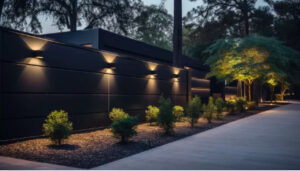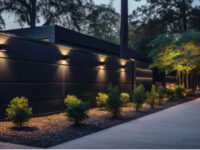Landscape Lighting Adds Beauty and Value to Your Home
Outdoor Lighting Orlando adds value to your home while creating gorgeous scenes you’ll love to enjoy at night. Wired landscape lights connect directly to your power supply and are controlled by timers, switches, or photocells. They can also be connected to Alexa for on-the-go control. These lights are a great option to highlight your favorite features like your fountain, pond, flower garden, patios, pergolas, and trees.
Landscape lighting is not all about illumination; it’s also about creating a warm, inviting atmosphere for guests to enjoy after dark. A well-designed lighting scheme creates beautiful glows, a mix of brightness and shadows, and draws attention to the features of your home, property, or garden.
The most common landscape lighting technique involves uplighting, where you illuminate the first few layers of the tree using fixtures placed low on the ground. This accentuates the tree’s natural shape and can help make it stand out in the nighttime. Uplighting is often used for trees in your yard, but it can also be applied to a stone feature or other landscape elements you want to draw attention to.
Another landscape lighting technique is silhouetting when you use a fixture positioned behind the feature and aimed at an adjacent wall to create an illuminated backdrop. This is perfect for highlighting interesting shapes in your landscaping, bringing out the color of stone features, and enhancing the overall look of your property at night.
Uplighting can be done for other landscape elements, including fountains, ponds, flower gardens, patios, pergolas, or just about any outdoor living space you have at home. But the most important aspect of uplighting is that it adds beauty and character to your landscape at nighttime, transforming your home into a bold showcase for your best landscaping elements.
Aside from adding curb appeal, landscape lighting can boost your home’s value when it comes time to sell. Potential buyers are drawn to homes with well-lit exteriors, making them feel safer and more welcoming.
Having an expert landscape lighting designer help you choose the right uplighting and downlighting techniques for your property is key. A layered lighting design that combines both methods is typically the most attractive. It would help if you also thought about the size and placement of your fixtures — you want people to notice the feature they’re lighting up, not the fixture itself. LED landscape lighting also gives you greater flexibility in light output (lumens), color temperature, beam spread, and more.
A well-lit outdoor space is a key element to home and garden design. It provides a safe walking experience, elevates the home’s architecture, and offers your property an added element of beauty. A National Association of Home Builders survey revealed that landscape lighting is among the highest-rated features that potential homeowners rate as desirable or essential.
With various fixtures available, the choices for lighting your landscape are endless. There’s something for everyone, from high-end, high-style lanterns to simple LED lights illuminating your favorite bushes. With the latest innovations in low voltage technology and LEDs, many of these newer fixtures look like the indoor lights you’re used to seeing in your home.
When it comes to landscape lighting, you’ll often see the term “spotlighting” or “accent lighting.” These techniques help draw attention to a specific feature of your landscape by shining light on it from different angles. They can highlight texture and height differences or create a grazing effect on a wall. Spotlights are among the most versatile landscape lighting fixtures and can come in a wide range of beam widths, bulbs, and wattages to fit the needs of any project.
Another popular technique is moonlighting, illuminating a feature by casting soft light onto it from below or to the side. This creates a dramatic silhouette or shadow effect on a structure, adding dimension and drama to an otherwise dull exterior.
Finally, pathway or path lighting is the most useful of all landscape lighting types. These lights help keep walkways, patios, and paths clear of debris, provide safety to guests, and make getting around your property at night a breeze. These are particularly useful if you have a lot of stairs or a sloped yard that could be dangerous after dark.
Before investing in landscape lighting, consider what you’re trying to accomplish and why. For example, if you plan on entertaining, invest in path lights to brighten the walkway from the driveway to the house. Or your front entryway may be too dark for security purposes, or you’d like to amp up the curb appeal of your property.
Hardscape features of your outdoor landscape include pathways, pavers, concrete or stone decks, retaining walls, and more. These artificial, hard surface features can easily be overlooked after dark, but with the right lighting placement, they can shine beautifully and add a whole new dimension to your garden. Hardscape lighting calls attention to these beautiful elements, illuminates walking areas for safety, and creates a welcoming ambiance after the sun goes down.
Many homeowners are intimidated when considering adding hardscape lighting to their outdoor landscape. Often, routing wires through retaining walls or decks is enough to turn them off from the idea altogether. However, there is no reason to feel this way. Hardscape lighting has only three applications and is very simple to install.
When highlighting a specific hardscape feature, like a fountain or a tree, it is important to aim multiple lights at the object. The crossing beams of the various lights will reduce any harsh shadowing that can occur with a single light aimed at an object. This style of lighting is popular with both modern and traditional home styles.
Step lighting is another great use for hardscape lighting. The light provides enough illumination for the user to safely walk up or down the steps. When choosing a stop light, it is important to opt for the available low-voltage models. This will help to save energy and extend the lifespan of the fixture.
The wattage of your hardscape lighting can also significantly impact its effectiveness and brightness. You will want to choose a light between 60 and 100 lumens, as this will provide a perfect balance of illumination and ambiance.
A key thing to remember when installing hardscape lighting is to leave a little extra wire if you need to service it. Ask your hardscape contractor to create a small channel in the top cap of a retaining wall or sitting wall for your fixture wire run when possible. This will make it easier for you to access the fixture.
As the name suggests, flood lights cast a broad swath of light across an area. These landscape lighting fixtures can be set to illuminate the space to the point that it is nearly as bright as daylight, or they can be dimmed to softly highlight a feature like a front entryway, a chimney, or a stately tree.
Generally, this type of lighting is used to highlight landscape features that do not need the attention of a spotlight’s narrow beam angle. They can also be incorporated between your uplighting to provide a fuller picture of the landscape as the sun sets and rises again.
These landscape lights often add depth and structure to walls, fences, garden beds, and other surfaces. They are also commonly installed to illuminate any outdoor furniture, sculpture, or other piece of art in your landscaping. The most important thing to remember when considering a flood light for your landscape is that it should be considerably dimmer than the spotlights you use to illuminate your focal points. This will help to avoid the problem of these lights contrasting too much with the other elements in your landscaping.
Uplighting is one of the most fundamental landscape lighting techniques to highlight tall plants or structures on your property. The idea is to create a silhouette or grazing effect with these lights, shining them from below so that the shape of the item stands out in contrast with its background. The best low-voltage landscape uplights can be found with a wide range of beam angles, wattages, and mounting options.
This type of lighting can be extremely versatile, allowing you to create different effects by combining it with other landscape lighting techniques. For example, uplighting can be paired with moonlighting to emphasize the soft light filtering through a dense tree canopy. Other popular methods include cross-lighting, mirror lighting, grazing, and silhouetting.




